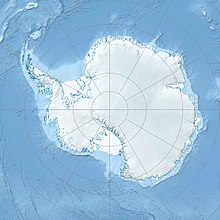Siple station
Coordinates: 75 ° 55 ′ 0 ″ S , 83 ° 55 ′ 0 ″ W.
The Siple Station was a research station located in Ellsworthland in West Antarctica . It was built in 1973 by the Space, Telecommunications, and Radioscience Laboratory of Stanford University to conduct experiments to study the magnetosphere with longitudinal waves (VLF). John P. Katsufrakis from Stanford University, who also financed the project, was responsible for the construction and the experiment . The Siple Station was closed upon completion of the research program in 1980. The Siple station was named after Paul Allman Siple , who was a member of Richard E. Byrd's Antarctic expeditions .
Location and structure
The location of the station was chosen near the magnetic south pole . The thick layer of ice at the site enabled an efficient dipole antenna in the 3 kHz range. The first station, Siple I , was destroyed by the ice and replaced by Siple II in 1979 . The original Siple I station had a crew of four, Siple II of eight, who each stayed on site through the winter.
The Siple II station used a 300 kW generator from Kato Engineering with rectangularly wound coils for the VLF transmitter, which was driven by a Caterpillar D353 motor. The receiver was in Roberval , Canada . At the time of its operation, the Siple II station had the longest dipole antenna in the world, from the original 12 miles (19.3 km) the antenna was gradually extended to 24 miles (38.6 km) and a second 24-mile antenna Antenna installed perpendicular to it.
The Utah State University also maintained a high-frequency radar experiment in Siple II station.
The station itself was a metal structure named after the manufacturer as a "Jamesway Hut" with the approximate dimensions of 85 m length, 13 m width and 7 m height. It was powered by two 110 kW generators powered by 3306 Caterpillar engines. Approximately 300,000 liters of hot oil were stored in three bladders for supply over the winter.
See also
Web links
- Description of the Siple station on the Stanford University website
Individual evidence
- ↑ STAR Lab website , accessed October 1, 2017.
- ↑ Description of the Siple station on the Stanford University website , accessed October 1, 2017.
- ↑ exact date / year unknown.
